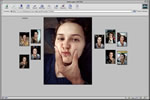| |
|
 |
|
 |
|
 |
|
 |
|
 |
|
 |
|
|
|

|
|

|
|
| |
  |
| We consider digital art, and specially net.art,
as one of the most original and genuine artistic
expressions in this time. As journalists we were
lucky to deal with subjects related to art development linked
to new technologies and with their impact on the world of art
and culture. In this way we witness -and to a certain extent we
contribute- its public evolution, at the same time as we could
know what happened in the “back room”. Our point of
view is the result of the union of these two information elements,
sifted through by a pragmatic approach to the subject and with
the perspective which concedes a history of ten years. It’s clear that net.art and the other formats related to
new technologies, and in a special way to information technologies,
correspond to a series of very specific conditions which have
happened in our time and they represent in no way an isolated
phenomenon outside the development of art history.
Net.art is the inheritor of experiments that,
since the appearance of these means, some artists have carried
out putting together two very powerful elements per se: communication
systems and art. The first attempts to use telecommunications
in art have very deep roots and their development is closely linked
to the technical evolution of the circle itself.
Artists working with the Internet want to reflect their creation, communication and exhibition spaces in an autonomous and independent way. They want to change their relation with the audience, dragging them out of their passive role and involving them in the creation of works where the process is often more important than the result. They want to change their relation with technology, using the situationist techniques of detournement to modify programs, changing their original functions and purposes for which they were invented. To the crisis of values and victory of market economy and wild neoliberalism they respond with immaterial works, which have nothing to do with the object, nor with the fetish object preserving the memory of an action. Unmarketable works in a society based on the accumulation of objects; works which do not require an exhibition space and establish a direct and personal connection to the user by means of the computer. We share the idea that the impact of the new digital technologies
on the contemporary artistic creation has marked the end
of post-modern period, which characterized the history
of art in the last 30 years, given birth to a new modern
age. Artists stop quoting and they create again. The
fascination of relativism, doubts and plurality of options in
postmodernists gives way to processuality, internationalism and
the wish to go beyond the local and global dichotomy in the digital
world. “There is a different creation sensibility to the
one which characterized the 80’s and 90’s. Digital
artists are the children of a technological revolution similar
to the industrial revolution at the end of XIX century, which
has also generated an experimental wish and attitude”, states
the curator and theorist Carolyn Christov Bakargiev.
The artists who appear between 1995 and 1998 (called “the
heroic period” by Olia Lialina), Vuk
Cosic, Jodi, Heath Bunting,
Alexei Shulgin and Lialina herself
know, value and focus their works on the digital technology, but
at the same time they establish references to the utopias of the
moderns in the beginning of XX century, ironic or not, like the
famous History of net.art by Cosic. A trilogy which begins with
History
of Art for Airports where he satirizes the representation
of art in the Net through a series of ideograms similar to those
you find in the airports, which represent key moments and creators
in the art history, from Lascaux to Wahorl, including
Heath Bunting. The dynamism and variety of the scene presages very interesting times. Sometimes it is difficult to give the accurate and suitable names to the more and more numerous forms/tendencies/trends of art in the Internet: art software, art browser, net.art, web-based projects, virtual reality, artivism, hacktivism, weblogs, telepresence, media-performance, artificial life environment... We love words and we like to look for and use the appropriate ones. However, names also can be used for starting endless arguments and debates can turn into futile controversies. Rather than setting labels or using them to classify a experience, names should be used to define it and, as far as possible, explain it. When net.art appeared even its name raised suspicions, with this odd spelling having a full stop in between, and this made it seem an inconsequential game. However, it is such a strong, powerful and different means as any one, that what some visionaries began has become a more and more extensive phenomenon, which join together countless experiences, in some cases far away from what was the concept of the first net.artists and the essence of the first works in net.art. There is no backward step. The contamination between
art and new technologies is already very advanced. The evolution
of means and medium has contributed to change the way of thinking
and creating. There will be more and more hybrid works and experiences,
which mix different means, medium and disciplines. The meaning
of these terms is fading away: means turn into content, medium
into means and information into art.
|